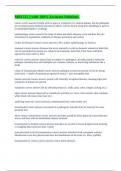Exam (elaborations)
MBI 111 || with 100% Accurate Solutions.
- Course
- Institution
carrier correct answers People with no signs or symptoms of a clinical disease, but the pathogens are inconspicuously harbored and shed to others. Can be chronic (long term shedding) or passive (contaminated hands or clothing) epidemiology correct answers the study of when and where diseases occ...
[Show more]



